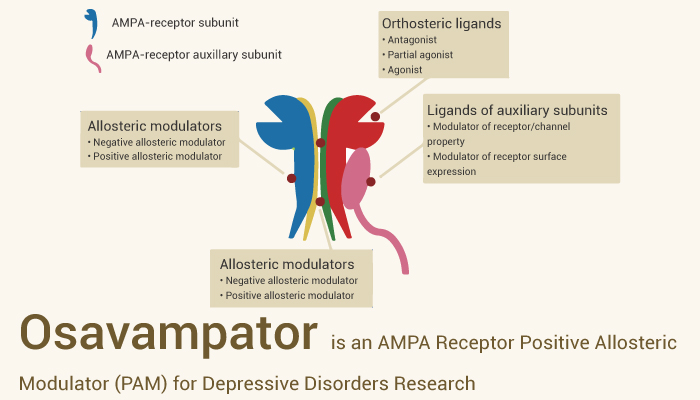AMPA receptor (AMPAR) is an ionotropic transmembrane receptor for glutamate (iGluR) that mediates fast synaptic transmission in the central nervous system (CNS). It has been traditionally classified as a non-NMDA-type receptor, along with the kainate receptor. AMPARs play a critical role in excitatory glutamatergic neurotransmission. The number and subunit composition of AMPARs at synapses determines the dynamics of fast glutamatergic signalling. Functional AMPARs on the cell surface are tetramers. Different subunit compositions confer distinct biophysical and molecular properties to AMPARs. For example, GluA2-containing receptors, which predominate in principal neurons, display a linear current-voltage relationship and are impermeable to Ca2+ due to constitutive Q/R (glutamine/arginine) editing of the GluA2 subunit. In contrast, GluA2-lacking receptors, which are often found in non-principal cells, display a double-rectification, have higher single-channel conductances and are Ca2+ permeable. Both the number and the subunit compositions of AMPARs vary amongst different brain regions/neuronal cell types and change during development, synaptic plasticity, and pathological states such as epilepsy. Thus tetrameric assembly of AMPARs represents a promising target for modulating AMPAR-mediated signalling in health and disease.
Osavampator (TAK-653) is an AMPA-R potentiator which exhibits minimal agonistic properties
Osavampator selectively binds to the ligand binding domain of recombinant AMPA-R in a glutamate-dependent manner. Besides, Osavampator strictly potentiated a glutamate-induced Ca2+ influx in hGluA1i-expressing CHO cells through structural interference at Ser743 in GluA1. In primary neurons, Osavampator augmented AMPA-induced Ca2+ influx and AMPA-elicited currents via physiological AMPA-R. Osavampator has virtually no agonistic effects in primary hippocampal neurons. Interestingly, Osavampator enhanced electrically evoked AMPA-R-mediated EPSPs more potently than AMPA or LY451646 in brain slices. Moreover, Osavampator improved cognition for both working memory and recognition memory, while LY451646 did so only for recognition memory, and AMPA did not improve either. Importantly, Osavampator has a wide safety margin against convulsion.
All in all, Osavampator is an AMPA receptor positive allosteric modulator. Osavampator selectively binds to AMPA-R in a glutamate-dependent manner. Osavampator improves learning and memory in many models.
References:
[1] Gan Q, et, al. J Physiol. 2015 Jan 1;593(1):39-48.
[2] Suzuki A, et, al. Sci Rep. 2021 Jul 15;11(1):14532.
